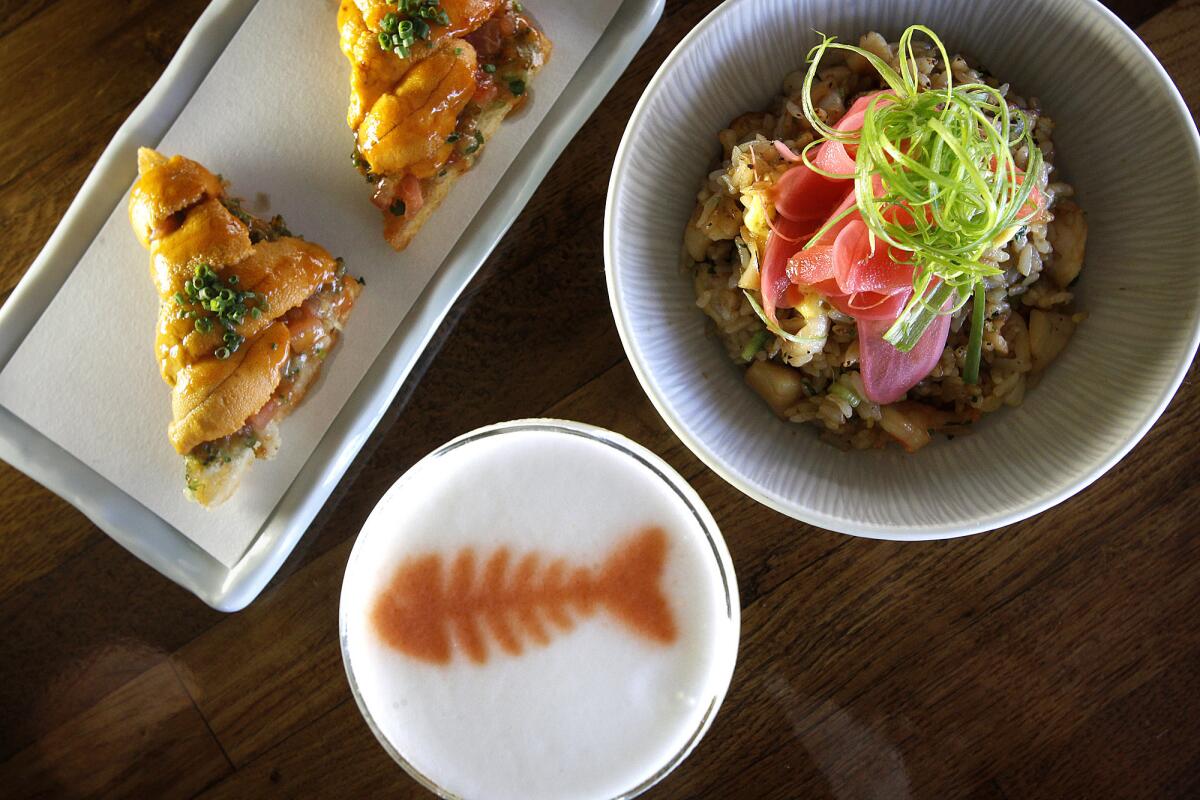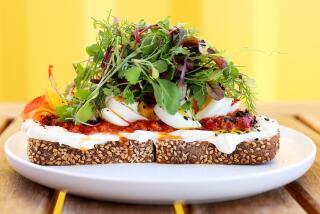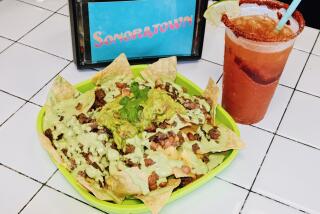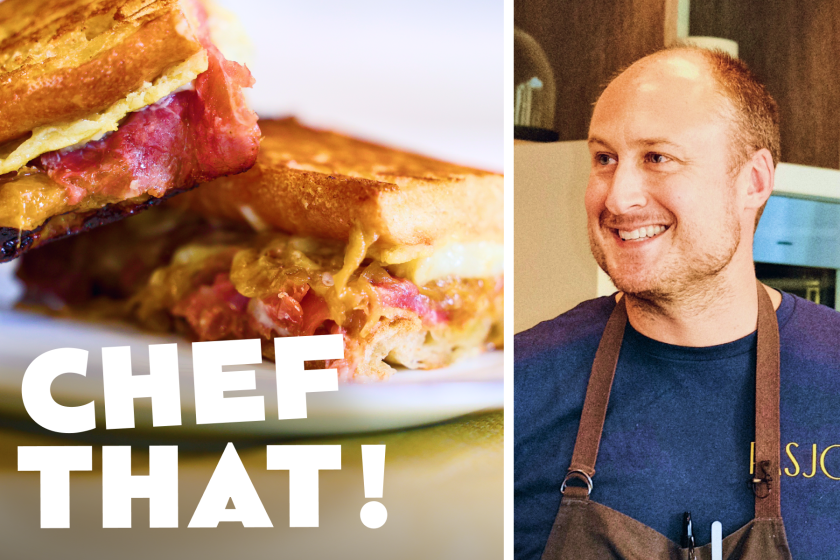Jonathan Gold | L.A. restaurant review: Paiche dips Asian influences into the Amazon

Paiche are enormous. Paiche have teeth on their tongues. Paiche, living fossils barely evolved since the Miocene epoch, have lungs and breathe air, which is pretty unusual for fish. Paiche are also easy to catch, a problem even in the sparsely populated Upper Amazon, where, despite laws against commercial fishing, they are becoming rare.
If your experience with paiche, also called pirarucu, comes mostly from the Discovery Channel, you may be surprised to learn of the existence of the local restaurant named Paiche, where customers may be observed consuming paiche tiradito, paiche tucked into lettuce leaves, grilled paiche ribs glazed with chile and sweet miso and paiche stewed in a spicy sauce. Upper Amazon eats are unexpected in Marina del Rey, even Upper Amazon eats that taste as if they’ve taken a swing through a Westside Asian pub.
Paiche (the restaurant) is a project of Ricardo Zarate, the Peruvian chef behind both the Peruvian gastropub Mo-Chica and the neo-Peruvian grill Picca. Before he started the original Mo-Chica in the Mercado La Paloma, Zarate, a Lima native, was best known for his fusiony Japanese cooking at Zuma in London and at Wabi-Sabi here on Abbot Kinney Boulevard. He is a chef whose ceviches are sometimes indistinguishable from sashimi and whose hamburgers occasionally include alpaca. He tends toward the flashy squeeze-bottle presentations fashionable in the better restaurants in Miraflores and also to a kind of miniaturization, so that what would probably be a huge plate of chaufa de langosta becomes a few spoonfuls of soupy rice with bits of lobster and other shellfish. The bar probably serves the best pisco sour in town, especially the version inflected with Japanese whiskey.
Paiche (the fish) is now being grown on sustainable eco-farms in the Peruvian Amazon, and its ability to thrive in smallish ponds apparently makes it an ideal candidate for aquaculture. With a mild taste and firm texture, it lends itself well to preparations like Zarate’s tiradito, in which it is briefly marinated in a citrusy chile-tinged vinaigrette and laid out on a bed of puréed sweet potato, and its apparently abundant fat helps it crisp up nicely on the grill. Paiche is what tilapia would be like if tilapia grew to several hundred pounds and actually tasted good. Paiche are actually fed tilapia on the fish farm. Somehow this seems appropriate.
Zarate conceived of his Paiche as the Peruvian equivalent of a Japanese izakaya, an informal drinking place where you order small dishes to nibble on as hunger strikes you instead of all at once as a meal — crisp, airy yuca fritters filled with molten Manchego cheese, or a salad of crisped quinoa flavored with mushroom duxelles and the musky Peruvian black oregano called huacatay, or thin slices of chile-rubbed pork neck from the grill.
When you are seated at the restaurant, which is large, crowded and blasted with a salsa soundtrack, you will be advised to order four or so dishes per person.
So where at an izakaya you might start with sashimi, at Paiche there is ceviche: sliced octopus or albacore or halibut, fish of sashimi quality, touched with chile-laced juice; or tiraditos — try the fairly Nobu-like kampachi with toasted garlic and spicy rocoto oil — hit with a slightly more intense marinade. At an izakaya, there will be skewers of kushiyaki, grilled things; at Paiche there are anticuchos — not the grilled beef heart that the name implies but charcoal-seared quail, sausage-stuffed squid or crunchy chicken sweetened with miso and Peruvian chile. (A Zarate dish will typically be flavored with Asian fermented soy, a bit of citrus and purées of one or more Peruvian chiles. His is a fairly maximalist cuisine.) Instead of the izakaya standard karaage, bits of fried chicken, there is tangy Peruvian chicharrones de pescado, cubes of crunchy fried fish.
As at his other restaurants, Zarate does have a bit of a clunky streak, especially when it comes to interpretations of modernist sushi. His tuna tartare served on crunchy lozenges of a fried bean and rice purée, tacu tacu, in homage to the much-copied tuna with crisp rice at Koi, is stodgy, and the combination of shrimp toast and less-than-perfect uni is just odd. After a few dishes, you will begin to ignore the omnipresent, claylike beds of starch; sometimes tacu tacu, sometimes puréed roots. The doughy sweet potato gnocchi are just odd.
But then you end up with a plate of quinoa “risotto” flavored with fresh peas, or a sort of duck confit in chile that could have come from the fanciest restaurant in Lima or the delicious granita of Peruvian purple corn flavored with cloves, and everything seems all right again. Another pisco sour? Why not.
Paiche
A Peruvian maximalist offers his take on Japanese izakaya.
LOCATION
13488 Maxella Ave., Marina del Rey, (310) 893-6100, paichela.com
PRICES
Appetizers, $8-$14; ceviches and sashimis, $8-$25; grilled dishes, $8-$16; hot dishes, $8-$38; desserts, $9-$12
DETAILS
Open 11:30 a.m. to 11:30 p.m. daily. Full bar. Lot parking. Credit cards accepted.
RECOMMENDED DISHES
Quinoa salad, kampachi tiradito, grilled pacu ribs, chicha raspadilla
More to Read
Eat your way across L.A.
Get our weekly Tasting Notes newsletter for reviews, news and more.
You may occasionally receive promotional content from the Los Angeles Times.










